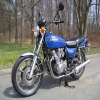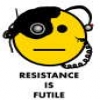Carb leak
- rhettman360
-
Topic Author
- Offline
- User
-

Registered
- Posts: 2
- Thanks: 0
Carb leak
18 Feb 2016 15:56
Hey guys, new to the forum, new to the bike, and new to carb work in general. So I bought a 2002 KZ1000 Police about two weeks ago. I've put about 100 miles on her since. Aside from having to adjust the clutch its been perfect. This morning I noticed that it was sitting in a puddle of gas. Upon inspection it was leaking out of the air box tubes from the middle two carbs and down the overflow tube. So I've taken the tank off and stopped the flow of gas at the petcock. Where should I start with this? And I apologize for my ignorance in advance. Thanks!
Please Log in or Create an account to join the conversation.
- SWest
-

- Offline
- Sustaining Member
-

Registered
- 10 22 2014
- Posts: 23570
- Thanks: 2952
Re: Carb leak
18 Feb 2016 16:11
Welcome, clear tube test.
Steve
Steve
Z1b1000 1975 Z1b
kzrider.com/forum/11-projects/598262-kz-...-will-it-live#672882
kzrider.com/forum/2-engine/597654-poser?start=240#704229
kzrider.com/forum/11-projects/598262-kz-...-will-it-live#672882
kzrider.com/forum/2-engine/597654-poser?start=240#704229
Please Log in or Create an account to join the conversation.
- 650ed
-

- Offline
- User
-

Registered
- Posts: 15339
- Thanks: 2833
Re: Carb leak
18 Feb 2016 16:30
Below is some info regarding Mikuni carbs. Your carbs may be different, but I suspect the info will still provide a starting point for diagnosing the problem. Ed
Fuel coming out of the overflow hose (the little hose on the bottom of the carb) is the common symptom of the 3 possible problems described below. Remember - NO SMOKING or other activities that could ignite the fuel while working on carbs!
The float valve is not sealing. This may be (and probably is) just a matter of some minor dirt in the float valve and is very simple to remedy and can be done with the carbs still on the bike. Turn off fuel; drain carb by loosening big brass screw near bottom; and remove the 4 little screws on the bottom of the carb bowl. This will enable you to remove the carb bowl. You will then see the float. If you carefully remove the float you will see a stubby little needle that mates with a brass orifice; together, these two pieces are the float valve. Assuming there is no obvious damage to the needle or seat, use a Q-tip and some carb cleaner to clean the seat of the orifice and the needle. Be careful not to bend the tang that is attached to the float. This tang is the piece that the bottom of the float valve needle rests upon, and it determines the fuel level in the bowl, so bending it will change the fuel level. With the float valve cleaned it should no longer leak. To prevent a re-occurrence a quality inline fuel filter should be installed between the fuel tank and carbs. If there was damage the needle and seat should be replaced as a set; they are available.
The brass overflow tube inside the carb bowl is damaged. When you remove the carb bowl you will see a brass tube attached inside and rising toward the top of the bowl. This is the overflow tube and it leads directly to the overflow nipple on the bottom of the carb. Normally, the fuel level within the bowl rises somewhat close to the top of this tube. If the tube becomes cracked or separates from the bottom of the carb bowl fuel will flow through it and out through the overflow hose. Checking the condition of the tube is very easy after you have removed the carb bowl from the carb. Simply hold the bowl level and fill it up near the top of the tube with water or alcohol and see if it leaks. A slight crack in the brass overflow tube can be difficult to find. You can connect a rubber tube to the overflow nipple, fill the bowl with water, put finger over the open end of the brass overflow tube and blow in the rubber end and look for bubbles. If it does the best remedy is to replace it although some folks have found creative ways to repair them.
The fuel level is set too high. This condition occurs when someone has bent the float tang as mentioned above. This condition can be checked using what is referred to as the "clear tube test." The test involves attaching one end of a clear piece of flexible tubing to the carb drain hole and holding the other end of the tube above the bowl/carb joint. When the fuel is turned on it should rise in the tube to a level 2.5 - 4.5 mm below the bowl/carb joint. If the fuel rises higher than that level it may run into the cylinders or over the upper end of the brass overflow inside the carb bowl (mentioned above) in which case it will run out the overflow hose. This condition is corrected by removing the float and gently bending the tang to raise the float valve needle position. Doing this may take several tries before achieving the desired fuel level.
Correcting each of these three conditions involves removing the carb bowl. This task can be made easier if a short screwdriver bit is used, and depending on which carb you are fixing a mirror may help you locate the screws on the bottom of the carb bowl. Also, it is not a bad idea to have a new carb bowl gasket available in case the old gasket is damaged while removing the carb bowl.
Fuel coming out of the overflow hose (the little hose on the bottom of the carb) is the common symptom of the 3 possible problems described below. Remember - NO SMOKING or other activities that could ignite the fuel while working on carbs!
The float valve is not sealing. This may be (and probably is) just a matter of some minor dirt in the float valve and is very simple to remedy and can be done with the carbs still on the bike. Turn off fuel; drain carb by loosening big brass screw near bottom; and remove the 4 little screws on the bottom of the carb bowl. This will enable you to remove the carb bowl. You will then see the float. If you carefully remove the float you will see a stubby little needle that mates with a brass orifice; together, these two pieces are the float valve. Assuming there is no obvious damage to the needle or seat, use a Q-tip and some carb cleaner to clean the seat of the orifice and the needle. Be careful not to bend the tang that is attached to the float. This tang is the piece that the bottom of the float valve needle rests upon, and it determines the fuel level in the bowl, so bending it will change the fuel level. With the float valve cleaned it should no longer leak. To prevent a re-occurrence a quality inline fuel filter should be installed between the fuel tank and carbs. If there was damage the needle and seat should be replaced as a set; they are available.
The brass overflow tube inside the carb bowl is damaged. When you remove the carb bowl you will see a brass tube attached inside and rising toward the top of the bowl. This is the overflow tube and it leads directly to the overflow nipple on the bottom of the carb. Normally, the fuel level within the bowl rises somewhat close to the top of this tube. If the tube becomes cracked or separates from the bottom of the carb bowl fuel will flow through it and out through the overflow hose. Checking the condition of the tube is very easy after you have removed the carb bowl from the carb. Simply hold the bowl level and fill it up near the top of the tube with water or alcohol and see if it leaks. A slight crack in the brass overflow tube can be difficult to find. You can connect a rubber tube to the overflow nipple, fill the bowl with water, put finger over the open end of the brass overflow tube and blow in the rubber end and look for bubbles. If it does the best remedy is to replace it although some folks have found creative ways to repair them.
The fuel level is set too high. This condition occurs when someone has bent the float tang as mentioned above. This condition can be checked using what is referred to as the "clear tube test." The test involves attaching one end of a clear piece of flexible tubing to the carb drain hole and holding the other end of the tube above the bowl/carb joint. When the fuel is turned on it should rise in the tube to a level 2.5 - 4.5 mm below the bowl/carb joint. If the fuel rises higher than that level it may run into the cylinders or over the upper end of the brass overflow inside the carb bowl (mentioned above) in which case it will run out the overflow hose. This condition is corrected by removing the float and gently bending the tang to raise the float valve needle position. Doing this may take several tries before achieving the desired fuel level.
Correcting each of these three conditions involves removing the carb bowl. This task can be made easier if a short screwdriver bit is used, and depending on which carb you are fixing a mirror may help you locate the screws on the bottom of the carb bowl. Also, it is not a bad idea to have a new carb bowl gasket available in case the old gasket is damaged while removing the carb bowl.
1977 KZ650-C1 Original Owner - Stock (with additional invisible FIAMM horn)
Please Log in or Create an account to join the conversation.
- TexasKZ
-

- Offline
- Platinum Member
-

Registered
- Posts: 8062
- Thanks: 2584
Re: Carb leak
18 Feb 2016 16:46
Please also be aware that the crankcase is now likely full of fuel. Check the engine oil level. If the sight glass is full, or if after removing the oil filler cap and taking a sniff, you smell fuel. Drain all the oil. Replace it and the filter with new, insuring that you use a JASO-MA oil.
Trying to start the engine with an over-full crankcase can lead to disaster. Even if it is not over-full, running the engine with fuel-contaminated oil can lead to expensive repairs or catastrophic failure.
Trying to start the engine with an over-full crankcase can lead to disaster. Even if it is not over-full, running the engine with fuel-contaminated oil can lead to expensive repairs or catastrophic failure.
1982 KZ1000 LTD parts donor
1981 KZ1000 LTD awaiting resurrection
2000 ZRX1100 not ridden enough
www.kzrider.com/11-projects/620336-anoth...uild-thread?start=24
1981 KZ1000 LTD awaiting resurrection
2000 ZRX1100 not ridden enough
www.kzrider.com/11-projects/620336-anoth...uild-thread?start=24
Please Log in or Create an account to join the conversation.
- rhettman360
-
Topic Author
- Offline
- User
-

Registered
- Posts: 2
- Thanks: 0
Re: Carb leak
19 Feb 2016 20:50
Alright I'll set to checking that tomorrow. Is there any reason this would happen simultaneously with both carbs 2 and 3? It just seems like too much of a coincidence.
Please Log in or Create an account to join the conversation.
- SWest
-

- Offline
- Sustaining Member
-

Registered
- 10 22 2014
- Posts: 23570
- Thanks: 2952
Re: Carb leak
20 Feb 2016 06:57
My carbs have two inlets but they are all tied together. Some aren't that way. Could be some grit got in the float valves. You should get some in line filters. About $5 at your local bike shop.
Steve
Steve
Z1b1000 1975 Z1b
kzrider.com/forum/11-projects/598262-kz-...-will-it-live#672882
kzrider.com/forum/2-engine/597654-poser?start=240#704229
kzrider.com/forum/11-projects/598262-kz-...-will-it-live#672882
kzrider.com/forum/2-engine/597654-poser?start=240#704229
Attachments:
Please Log in or Create an account to join the conversation.
Moderators: Street Fighter LTD
